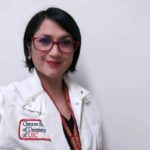The temporomandibular joint (TMJ) is one of the most complex joints in the body. It is considered a ginglymoarthrodial joint because it provides rotation (ginglymoid) and translation (arthrodial) movements [1]. It is formed by the mandibular condyle and the temporal bone; the condyle fitting into the mandibular fossa of the temporal bone produces the articulation. Between these two bones and preventing direct contact, the collateral ligaments attach an articular disc laterally and medially to the condyle. When opening and closing the mouth, these ligaments allow the disc’s rotational movement on the condyle. Translation occurs when the condyle is out of the fossa during wide mouth opening [1, 2].
The temporomandibular joint (TMJ) plays a crucial role in facilitating the complex movements of the jaw, enabling functions like talking, chewing, and yawning. However, like any joint in the body, the TMJ can be susceptible to various conditions, including internal derangement.
Internal Derangement is the category of conditions that group the abnormal function of the intra-articular structures and is a non-specific term applied as a descriptive subdivision term for non-arthritic TM joint disorders (e.g., disc displacement with reduction [DDWR], disc displacement without reduction [DDNR], open dislocation, full & partial open locking) [3].
Like what you’re learning? Download a brochure for our Orofacial Pain and Oral Medicine certificate or master’s degree program.
When the temporomandibular joint (TMJ) emits sounds like clicking or popping, it signals the presence of an internal derangement, specifically characterized by the displacement of the disc with reduction. In this context, “reduction” denotes the disc being successfully restored to its position during the joint’s movement (2,3). This is a common condition in the general population, especially the younger population. In the Orofacial Pain and Oral Medicine Center of USC, it is the third most common condition, with a prevalence of 14,86%.
In cases where the displacement is notable, individuals may encounter a brief or intermittent restriction in the translation of the condyle before the disc reverts to its standard position, allowing for complete translation. The achievement of full condyle translation following a click or lateral shift in the jaw joint implies either the release or reduction of the momentarily jammed disc [2, 3].
This release permits the disc to resume its regular rotational movement around the condyle during the opening of the jaw. Upon closure, the disc returns to its initial position relative to the condyle, completing the cycle [2, 4].
The ICD-10 code for the TMJ articular disc disorder is M26.63, with a modifier regarding the side (1 for right, 2 for left, and 3 for bilateral), and the ICD-11 DA0E.8 under the category of temporomandibular disorders [5, 6].
What are the Possible Causes?
- Overload and overstretching of the ligaments are usually due to repetitive strain of habit or parafunction. (e.g. bruxism, clenching or gum chewing).
- Early changes in degenerative joint diseases
- Disc ligament laxity problem (usually present in individuals with hyperflexibility).
- Trauma damaging discs or ligaments [7].
What are the Possible Symptoms Associated with it?
- Pain: Persistent pain in the jaw joint, often worsened by movement or chewing.
- Clicking or Popping Sounds: Audible sounds, such as clicking or popping, when opening or closing the mouth (4).
How is it Diagnosed?
A stethoscope is recommended to examine any clicking better, popping, or snapping noises during clinical examination (Figure 1). An individual may present clinical history and examination positive for the following:
- History of the last 30 days with a repeatable clicking of the TMJ with an opening or closing (or both) motion of the jaw (mainly while functioning)
- The mouth opening should be normal in magnitude (>45mm)
- The mouth-opening pathway should end up on the midline when wide open, or there is a temporary shift of the midline until the click occurs, then it returns to the midline [3].
- Imaging for evaluating the intraarticular disc of the TMJ is recommended only in severe cases and when a definitive diagnosis is not well established with history and clinical evaluation. The sensitivity of the MRI is 0,34, and the specificity is 0.92 (1).

Figure 1. Dr. Vistoso demonstrated using a stethoscope and anatomical parameters to examine TMJ noises in mannequins.
Possible treatment options
- One of the most important recommendations is avoidance of joint noise therapy, which includes stopping all opening or lateral or forward shifting of the jaw that causes a joint sound (ideally less than 5 times a day)
- Recommend chewing food on the side that does not produce joint noises
- Recommend cutting and tearing any more oversized food items or selecting only small, soft foods that can be eaten without causing joint noises.
Optional Treatment with Debatable Evidence
- If the joint noises cannot be avoided, hyalgan injection can reduce joint friction for 2-3 weeks and be repeated up to 4 times a year (every three months) [8].
- Occlusal splints [1, 7, 9]
- Surgical Intervention [10]
Conclusion
Internal derangement of the TMJ can significantly impact a person’s quality of life, affecting daily activities that involve jaw movement. Suppose you suspect you have symptoms related to TMJ issues. In that case, consulting with a healthcare professional or a dentist specializing in temporomandibular disorders is crucial for a comprehensive evaluation and appropriate management. Early intervention and a tailored treatment plan can help alleviate symptoms and improve the overall health of the TMJ.
Earn an Online Postgraduate Degree in Orofacial Pain and Oral Medicine
Are you interested in a variety of issues focused on orofacial pain, medicine and sleep disorders? Consider enrolling in the Herman Ostrow School of Dentistry of USC’s online, competency-based certificate or master’s program in Orofacial Pain and Oral Medicine.
References
- Klasser G, Romero M, editors. Orofacial Pain: Guidelines for Assessment, Diagnosis, and Management. 7th ed. Chicago: Quintessence Publishing Co., Inc; 2023.
- Young AL. Internal derangements of the temporomandibular joint: A review of the anatomy, diagnosis, and management. J Indian Prosthodont Soc. 2015 Jan-Mar;15(1):2-7. doi: 10.4103/0972-4052.156998. PMID: 26929478; PMCID: PMC4762294.
- https://ostrowonline.usc.edu/internal-derangements-of-the-temporomandibular-joint/
- Rady NA, Bahgat MM, Abdel-Hamid AM. Promising minimally invasive treatment modalities for symptomatic temporomandibular joint disc displacement with reduction: a randomized controlled clinical trial. BMC Oral Health. 2022 Dec 1;22(1):547. doi: 10.1186/s12903-022-02579-3. PMID: 36456937; PMCID: PMC9714147.
- https://www.findacode.com/icd-11/code-897101649.html
- https://www.icd10data.com/ICD10CM/Codes/M00-M99/M26-M27/M26-/M26.63
- https://my.clevelandclinic.org/health/symptoms/24665-jaw-popping
- Sequeira J, Rao BHS, Kedia PR. Efficacy of Sodium Hyaluronate for Temporomandibular Joint Disorder by Single-Puncture Arthrocentesis. J Maxillofac Oral Surg. 2019 Mar;18(1):88-92. doi: 10.1007/s12663-018-1093-4. Epub 2018 Feb 27. PMID: 30728698; PMCID: PMC6328828.
- Nehal Solanki, Balendra Pratap Singh, Pooran Chand, Ramashankar Siddharth, Deeksha Arya, Lakshya Kumar, Suryakant Tripathi, Hemant Jivanani, Abhishek Dubey. Effect of mandibular advancement device on sleep bruxism score and sleep quality. The Journal of Prosthetic Dentistry. Volume 117, Issue 1, 2017. Pages 67-72.
- Marlière DAA, Vicentin Calori MJA, Medeiros YL, Santiago RC, Strujak G, Asprino L. Clinical outcomes of the discopexy using suture anchors for repositioning disc displacement in temporomandibular joints: Systematic review and meta-analysis. J Craniomaxillofac Surg. 2023 Jul-Aug;51(7-8):475-484. doi: 10.1016/j.jcms.2023.06.007. Epub 2023 Jun 27. PMID: 37517977.


